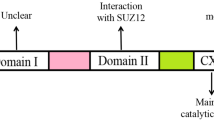Abstract
Heat shock cognate protein 70 (Hsc70) is a key mediator for the maintenance of intracellular proteins and regulates cellular activities. And it is elevated in various tumor tissues including glioma, which is closely related to the malignancy and poor prognosis of the tumors. However, the effects of Hsc70 on gliomas and its regulatory mechanism have not yet been elucidated. In the present study, we found that Hsc70 was overexpressed in glioma tissues and cultured glioma cells. Furthermore, Hsc70 expression exhibited positive correlation with the grades of gliomas. Knockdown of Hsc70 could effectively inhibit cell proliferation and increase cell apoptosis. Furthermore, we identified that β4GalT5 was a critical target for Hsc70-mediated anti-glioma effects. Blocking β4GalT5 activity could effectively reverse the anti-tumor effect of Hsc70. Taken together, these data indicate that Hsc70 regulates β4GalT5 levels, and possibly plays a role in cell proliferation and apoptosis of glioma.





Similar content being viewed by others
References
Beaman, G. M., Dennison, S. R., Chatfield, L. K., & Phoenix, D. A. (2014). Reliability of HSP70 (HSPA) expression as a prognostic marker in glioma. Molecular and Cellular Biochemistry, 393(2), 301–307.
Beckmann, R. P., Mizzen, L. E., & Welch, W. J. (1990). Interaction of Hsp 70 with newly synthesized proteins: Implications for protein folding and assembly. Science, 248(4957), 850–854.
Bukau, B., & Horwich, A. L. (1998). The Hsp70 and Hsp60 chaperone machines. Cell, 92(3), 351–366.
Chen, X., Jiang, J., Yang, J., Chen, C., Sun, M., Wei, Y., Guang, X., & Gu, J. (2006). Down-regulation of the expression of beta1, 4-galactosyltransferase V promotes integrin beta1 maturation. Biochemical and Biophysical Research Communication, 343(3), 910–916.
Cui, C., Chen, X., Liu, Y., Cao, B., Xing, Y., Liu, C., Yang, F., Li, Y., Yang, T., Hua, L., Tian, M., Wei, Y., Gong, Y., & Jiang, J.β(2017). β1,4-Galactosyltransferase V activates Notch1 signaling in glioma stem-like cells and promotes their transdifferentiation into endothelial cells. Journal of Biological Chemistry. https://doi.org/10.1074/jbc.RA117.000682.
D’Arrigo, P., Russo, M., Rea, A., Tufano, M., Guadagno, E., Del Basso De Caro, M. L., Pacelli, R., Hausch, F., Staibano, S., Ilardi, G., Parisi, S., & Romano, M. F. (2017). A regulatory role for the co-chaperone FKBP51s in PD-L1 expression in glioma. Oncotarget, 8(40):68291–68304.
Ding, Y., Song, N., Liu, C., He, T., Zhuo, W., He, X., Chen, Y., Song, X., Fu, Y., & Luo, Y. (2012). Heat shock cognate 70 regulates the translocation and angiogenic function of nucleolin. Arteriosclerosis, Thrombosis, and Vascular Biology, 32(9), 126–134.
Ferguson, S. D. (2011). Malignant gliomas: Diagnosis and treatment. Disease-a-Month, 57(10), 558–569.
Hantschel, M., Pfister, K., Jordan, A., Scholz, R., Andreesen, R., & Schmitz, G. (2000). Hsp70 plasma membrane expression on primary tumor biopsy material and bone marrow of leukemic patients. Cell Stress and Chaperones, 5(5), 438–442.
Hartl, F. U., & Hayer-Hartl, M. (2002). Molecular chaperones in the cytosol: From nascent chain to folded protein. Science, 295(5561), 1852–1858.
Isomoto, H., Oka, M., Yano, Y., Kanazawa, Y., Soda, H., Terada, R., Yasutake, T., Nakayama, T., Shikuwa, S., Takeshima, F., Udono, H., Murata, I., Ohtsuka, K., & Kohno, S. (2003). Expression of heat shock protein (Hsp) 70 and Hsp 40 in gastric cancer. Cancer Letters, 198(2), 219–228.
Jiang, J., Chen, X., Shen, J., Wei, Y., Wu, T., Yang, Y., Wang, H., Zong, H., Yang, J., Zhang, S., Xie, J., Kong, X., Liu, W., & Gu, J. (2006). Beta1,4-galactosyltransferase V functions as a positive growth regulator in glioma. Journal of Biological Chemistry, 281(14), 9482–9489.
Kumagai, T., Sato, T., Natsuka, S., Kobayashi, Y., Zhou, D., Shinkai, T., & Hayakawa, S., & Furukawa, K. (2010). Involvement of murine β-1,4-galactosyltransferase V in lactosylceramide biosynthesis. Glycoconjugate Journal, 27(7–9), 685–695.
Liu, W., Vielhauer, G. A., Holzbeierlein, J. M., Zhao, H., Ghosh, S., Brown, D., Lee, E., & Blagg, B. S. (2015). KU675, a concomitant heat-shock protein inhibitor of Hsp90 and Hsc70 that manifests isoform selectivity for Hsp90α in prostate cancer cells. Molecular Pharmacology, 88(1), 121–130.
Ramp, U., Mahotka, C., Heikaus, S., Shibata, T., Grimm, M. O., Willers, R., & Gabbert, H. E. (2007). Expression of heat shock protein 70 in renal cell carcinoma and its relation to tumor progression and prognosis. Histology and Histopathology, 22(10), 1099–1107.
Robertson, T., Koszyca, B., & Gonzales, M. (2011). Overview and recent advances in neuropathology. Part 1: Central nervous system tumours. Pathology, 43(2), 88–92.
Shirane, K., Sato, T., Segawa, K., & Furukawa, K. (1999). Involvement of beta-1,4-galactosyltransferase V in malignant transformation-associated changes in glycosylation. Biochemical and Biophysical Research Communication, 265(2), 434–438.
Tanaka, M., Mun, S., Harada, A., Ohkawa, Y., Inagaki, A., Sano, S., Takahashi, K., Izumi, Y., Osada-Oka, M., Wanibuchi, H., Yamagata, M., Yukimura, T., Miura, K., Shiota, M., & Iwao, H. (2014). Hsc70 contributes to cancer cell survival by preventing Rab1A degradation under stress conditions. PLoS ONE, 9(5), e96785.
Vila-Carriles, W. H., Zhou, Z. H., Bubien, J. K., Fuller, C. M., & Benos, D. J. (2007). Participation of the chaperone Hsc70 in the trafficking and functional expression of ASIC2 in glioma cells. Journal of Biological Chemistry, 282(47), 34381–34391.
Wang, B. S., Yang, Y., Yang, H., Liu, Y. Z., Hao, J. J., Zhang, Y., Shi, Z. Z., Jia, X. M., Zhan, Q. M., & Wang, M. R. (2013). PKCι counteracts oxidative stress by regulating Hsc70 in an esophageal cancer cell line. Cell Stress and Chaperones, 18(3), 359–366.
Acknowledgements
This work was supported by the National Natural Science Foundation of China (81672499), Jiangsu Province’s Natural Science Foundation (BK20141256, BK20161318), and Yancheng Medical Science Development Foundation (YK2014011, YK 2015001). Top Talent Project of six-one-projects (LGY2018038).
Author information
Authors and Affiliations
Corresponding authors
Ethics declarations
Conflict of interest
The authors declare no potential conflicts of interest.
Additional information
Publisher’s Note
Springer Nature remains neutral with regard to jurisdictional claims in published maps and institutional affiliations.
Rights and permissions
About this article
Cite this article
Sun, G., Cao, Y., Dai, X. et al. Hsc70 Interacts with β4GalT5 to Regulate the Growth of Gliomas. Neuromol Med 21, 33–41 (2019). https://doi.org/10.1007/s12017-018-08520-8
Received:
Accepted:
Published:
Issue Date:
DOI: https://doi.org/10.1007/s12017-018-08520-8




